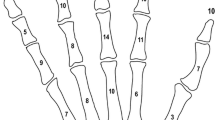Abstract
Current guidelines suggest early surgical treatment of open fractures. This rule in open hand fractures is not well supported and may be unpractical. Furthermore, desirable debridement and washout can be obtained in the emergency department (ED). The purpose of this study was to evaluate the relationship between the level of contamination, quality of washout in the emergency room, and the development of infection. Sixty-one patients with open fractures of the hand were retrospectively reviewed for demographic and fracture characteristics, and other complications. The infection rate was 14.8%. Contamination was present in 43 patients (70.5%). One thousand milliliters or more were used to obtain a grossly clean wound in 43 patients (70.5%). No significant relationship was found between fracture type, finger involved, hand dominance, comorbidities, and development of infection. The amount of fluid used for washout was significantly related to infection (P = 0.047), whereas wound contamination was not (P = 0.259). Type of oral antibiotic was significantly related to infection (P = 0.039). The level of contamination was not a significant factor in predicting infection, whereas the amount of fluid used for washout and the oral antibiotic type were significant factors in preventing infection. Since administration of intravenous antibiotics and thorough wound cleansing can be performed on open hand fractures in the ED under adequate anesthesia, most open fractures in the hand do not need to be treated early in the operating theater.
Similar content being viewed by others
References
Prodromidis AD, Charalambous CP (2016) The 6-hour rule for surgical debridement of open tibial fractures: a systematic review and meta-analysis of infection and nonunion rates. J Orthop Trauma 30(7):397–402. doi:10.1097/BOT.0000000000000573
Capo JT, Hall M, Nourbakhsh A, Tan V, Henry P (2011) Initial management of open hand fractures in an emergency department. Am J Orthop (Belle Mead NJ) 40(12):E243–E248
Swanson TV, Szabo RM, Anderson DD (1991) Open hand fractures: prognosis and classification. J Hand Surg Am 16(1):101–107
Schlitzkus LL, Goettler CE, Waibel BH, Sagraves SG, Hasty CC, Edwards M, Rotondo MF (2011) Open fractures: it doesn’t come out in the wash. Surg Infect (Larchmt) 12(5):359–363. doi:10.1089/sur.2010.075
Khatod M, Botte MJ, Hoyt DB, Meyer RS, Smith JM, Akeson WH (2003) Outcomes in open tibia fractures: relationship between delay in treatment and infection. J Trauma 55(5):949–954. doi:10.1097/01.TA.0000092685.80435.63
Ng T, Unadkat J, Bilonick RA, Wollstein R (2014) The importance of early operative treatment in open fractures of the fingers. Ann Plast Surg 72(4):408–410. doi:10.1097/SAP.0b013e318264fcd5
Zumsteg JW, Molina CS, Lee DH, Pappas ND (2014) Factors influencing infection rates after open fractures of the radius and/or ulna. J Hand Surg Am 39(5):956–961. doi:10.1016/j.jhsa.2014.02.008
Metcalfe D, Aquilina AL, Hedley HM (2016) Prophylactic antibiotics in open distal phalanx fractures: systematic review and meta-analysis. J Hand Surg Eur 41(4):423–430. doi:10.1177/1753193415601055
Ciclamini D, Panero B, Titolo P, Tos P, Battiston B (2014) Particularities of hand and wrist complex injuries in polytrauma management. Injury 45(2):448–451. doi:10.1016/j.injury.2013.09.016
Zalavras CG, Patzakis MJ, Holtom PD, Sherman R (2005) Management of open fractures. Infect Dis Clin North Am 19(4):915–929. doi:10.1016/j.idc.2005.08.001
Crowley DJ, Kanakaris NK, Giannoudis PV (2007) Debridement and wound closure of open fractures: the impact of the time factor on infection rates. Injury 38(8):879–889. doi:10.1016/j.injury.2007.01.012
Crowley DJ, Kanakaris NK, Giannoudis PV (2007) Irrigation of the wounds in open fractures. J Bone Joint Surg Br 89(5):580–585. doi:10.1302/0301-620X.89B5.19286
McLain RF, Steyers C, Stoddard M (1991) Infections in open fractures of the hand. J Hand Surg Am 16(1):108–112
Glueck DA, Charoglu CP, Lawton JN (2009) Factors associated with infection following open distal radius fractures. Hand (N Y) 4(3):330–334. doi:10.1007/s11552-009-9173-z
Anglen JO (2001) Wound irrigation in musculoskeletal injury. J Am Acad Orthop Surg 9(4):219–226
Patzakis MJ, Wilkins J, Moore TM (1983) Considerations in reducing the infection rate in open tibial fractures. Clin Orthop Relat Res 178:36–41
Anglen JO (2005) Comparison of soap and antibiotic solutions for irrigation of lower-limb open fracture wounds. A prospective, randomized study. J Bone Joint Surg Am 87(7):1415–1422. doi:10.2106/JBJS.D.02615
American Diabetes Association Diabetes Statistics (2007). http://www.cdc.gov/diabetes/pubs/pdf/ndfs_2007.pdf
Author information
Authors and Affiliations
Corresponding author
Ethics declarations
Conflict of interest
The authors have no conflicts to disclose.
Human and animal rights
All human and animal studies have been approved by the appropriate ethics committee and have therefore been performed in accordance with the ethical standards laid down in the 1964 Declaration of Helsinki and its later amendments.
Informed consent
The patients were treated according to standard of care and did not sign an informed consent for the study.
Rights and permissions
About this article
Cite this article
Basat, N.B., Allon, R., Nagmi, A. et al. Treatment of open fractures of the hand in the emergency department. Eur J Orthop Surg Traumatol 27, 415–419 (2017). https://doi.org/10.1007/s00590-017-1924-x
Received:
Accepted:
Published:
Issue Date:
DOI: https://doi.org/10.1007/s00590-017-1924-x




